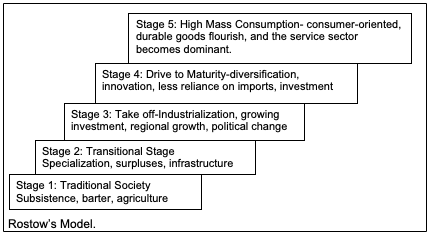According to Rostow’s linear model of development, countries tend to develop in a linear path. He was a controversial American Economic historian credited for the development of the five-stage model drawn below.
Strengths
- The model helps in explaining why some countries achieve some degree of development and then slip back. This, according to the model, is due to the failure to meet the conditions for that particular stage of economic development (Smithies 18).
- It challenges developing countries to identify their unique resources and invest in them so as to supply to the international market and hence fuel their economic growth from one stage to an advanced one.
Disadvantages
- The model draws from historical evidence, especially from developed countries, and argues that other countries would strictly follow the same pattern, which may not be the case (Smithies 19).
- Rostow’s model does not state the driving force behind the witnessed changes, and hence it is not reliable.
- It is designed in line with the American and European experience and assumes that all countries should be high mass consumers without taking into consideration other important factors.
- The model advocates for “capitalist ideals.”

Works cited
Smithies, Deborah. Development economics digital textbook. Tutor2u Limited, 2009: 18-19.